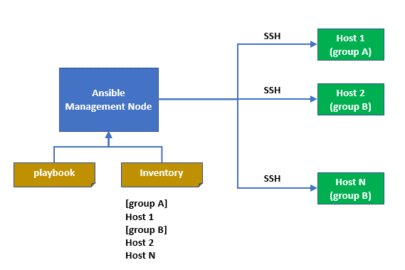By Keshav Khatore
| May 26, 2020 | In
Articles
| Update: May 26, 2020
| Total Views [ 1630 ]
Ansible is a mechanization stage that Implements a lot simpler approach to deploy applications. Ansible is an open-source automation tool used to perform undertakings that encompass provisioning, configuration management, continuous delivery, application deployment, networking, and security compliance. Ansible, or all the more correctly the Ansible Engine, is introduced on a controller machine and command-line interface (CLI) for executing basic specially appointed orders.The Ansible Engine likewise gives another executable to working against playbooks. Playbooks are a decisive meaning of a lot of consecutive errands run in parallel over a gathering of hosts. The basic executable is ansible and the definitive executable is ansible-playbook.
Why Ansible
First off, Ansible is open source and "free". As a venture scales their Ansible impression, regularly past 10 hosts, monitoring arrangement conditions starts to become testing particularly if the impression is going to keep on developing. To address this, Red Hat gives an solution called Ansible Tower. Conversely, Ansible requires no remote specialist as opposed to utilizing SSH as an association instrument to remote hosts. In such a manner, Ansible is significantly more lightweight than other application arrangement arrangements. Ansible is extremely simple to arrange. It requires a straightforward introduction on a controller machine and requires no extraordinary coding aptitudes to execute. In spite of the fact that the premise of this is valid, it doesn't imply that just anybody can structure Ansible playbooks, but instead playbooks require no extraordinary coding abilities to understand and get. Ansible is operator less and requires no extra programming or open ports on the remote hosts. This gives more prominent adaptability in arranging the whole application regardless of where the remote hosts are found. Without the requirement for extra programming, Ansible leaves more assets accessible for the sent application.
Ansible Architecture
The Ansible architecture comprises of a few pieces that structure its condition.
- Modules are little projects that go about as building squares embodying normal assignments, for example, utilizing yum to introduce bundles or ping to test the association with a remote host. Until now, there are at least 450 Ansible modules for normal errands and a lot more for middleware and foundation devices. On availing the instance, the users can directly start using Ansible without any additional overhead. The users already have access to the running commands as well as the resource modules. It helps in making the use more straightforward. The modules of ansibles are very easy to write, and this makes the task execution even simpler.
- Plugins give an approach to broaden Ansible's functionality. Ansible gives its very own portion and there is a system for composing custom modules. Modules are the additional codes that enlarge the functionality. All the nodes and control machines utilized with Ansible are recorded under inventories with databases, IP locations, and servers. Playbooks of the ansible design resemble the guidance manuals for playing out the assignments. They are the simple YAML composed files that make ansible progressively well known. The APIs help in broadening the association kinds of Ansible, callbacks, and others.
- The inventory record is the core of the Ansible condition. The inventory document is a basic ini or YAML record that characterizes the entirety of the remote has in scope. The inventory contains the entirety of the server data for an organization with send targets regularly sorted out in gatherings, for example, web servers, database servers, and so on. One can likewise dole out factors to servers utilizing the inventory record. managing inventory is additionally a fundamental piece of how Ansible functions. Ansible speaks to all the machines that it manages on a basic INI document. It places all the managed machines into groups as per the decision of the clients. To include new machines, there is no prerequisite for extra SSL signings. It helps in eliminating out all the issues identifying with DNS or NTP. The elimination of SSL marking expels the problem of connecting a specific machine.
- Playbooks contain the meaning of guidelines for an organization. The playbook characterizes a lot of consecutive undertakings and activities that apply to an assortment of remote servers characterized in an inventory record. In the event that the undertaking is applied to a gathering of servers, (for example, the entirety of the web servers) in the inventory record, that assignment will execute on the entirety of the servers of the gathering in equal and won't continue until that errand finishes on all servers. Remember that errands in playbooks execute consecutively and if there is one negative to Ansible that would be it. Playbooks of ansible help in finely orchestrating the infrastructure topology of the users. The simplicity of automation with Ansible is a feature that makes it more demanding.

The Working of Ansible
Realizing what Ansible is, its advantages, and uses, the following large thing to recollect is the means by which Ansible works. The way toward working of Ansible can't be separated into methodology or steps. To comprehend the working of the product, one needs to see all the various stages one after another. Ansible works by associating the server of the client through the SSH keys and pushing the little projects out. With the utilization of modules, the playbooks help the ansible customers in playing out all the particular undertakings. The specific capacities can incorporate the administration of restarting, introducing bundles, rebooting servers, and substantially more. With the utilization of Ansible, a great deal of things can be performed.
I am Keshav Khatore student of Lovely Professional University, Phagwara, Punjab, India, currently pursuing Masters In Computer Application.I am a Member of Redhat Linux, the biggest network on the planet and it's a glad thing for me to be a piece of such extraordinary and lofty community. I expert in Linux and have certification Red-hat Certified System Administration .
For Contact- keshavmah27@gmail.com ||
LinkedIn- https://www.linkedin.com/in/keshav-khatore/





















